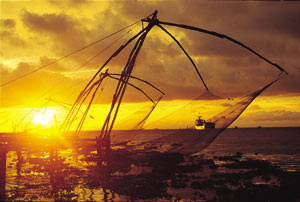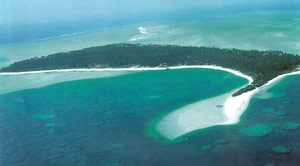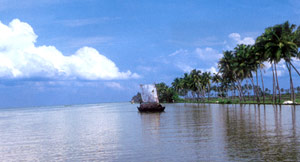|
|
Indianvisitoffers complete tourist information on the Indian state of Cochin, tourism in Cochin India, hotels in Cochin India and packages for Cochin India.
|
|
Cochin
Cochin � Facts and Figures

| Area | 8,700 sq km |
| Population | 1,600,000 |
| Languages | Malayalam and English |
| Best time to visit | December to May |
| STD code | 0484 |
Cochin � Introduction
In Cochin or Kochi dawn is not often a thing of breathtaking beauty, but just a careless smear of tinted light where sea and sky unite.
Daybreak is full of indeterminate promise. A slow lividness at the mist-obscured harbor mouth meets the swelling untamed surge of the ocean. Cargo-laden barges and vallams or country boats move, ponderously slow, over the sprawling vastness of the Vembanad Kayal, Kerala�s largest lake that spreads full bosomed and silver gray in the sultry sun.
Cochin � Location
Popularly referred to as the Queen of the Arabian Sea, Cochin is located on the west cost of India in the beautiful state of Kerala. The city can be regarded as the commercial and industrial capital of Kerala. The city extends from latitude 9�58' in the North to longitude 76�17' in the East.
Cochin � Climate
Being situated very close to the sea, Cochin has a moderate climate, with heavy rains during June�August due to the southwest monsoon. Winter starts from December and continues till February. In summer, the temperature rises to a maximum of 35�C and 25�C in the winters. Annual average rainfall is 310 cm.
Cochin � History
 Though Cochin had been an important roadstead in days gone by, it became a natural harbor only when nature decreed it so. Muziris (present-day Kodungalloor on the mouth of the Periyar River), 40 km north of Cochin, was the center of trade with ancient Rome in the products like pepper and pearls, fine silks, cotton, muslin, honey, oil, betel, tortoise shell, cinnamon leaf, black pepper, ginger grass, and indigo.
Though Cochin had been an important roadstead in days gone by, it became a natural harbor only when nature decreed it so. Muziris (present-day Kodungalloor on the mouth of the Periyar River), 40 km north of Cochin, was the center of trade with ancient Rome in the products like pepper and pearls, fine silks, cotton, muslin, honey, oil, betel, tortoise shell, cinnamon leaf, black pepper, ginger grass, and indigo.
The formation of Cochin harbor has a violent story of which nature herself was the main character. The harbor was formed in a.d. 1341, when a great flood in the Periyar River led to an outlet in the sea. The floods had meanwhile silted up the mouth of the Muziris harbor and this rich ancient port was banished to the footnotes of history. Meanwhile, the merchants of Muziris shifted to Cochin.
For centuries, Cochin was the battleground of European powers for the mastery of the lucrative trade of the Indian west coast. The fortunes of political powers in Cochin were dictated by pepper. The Portuguese were the first to come in. Two years later, the adventurous mariner, the legendary Vasco da Gama himself landed in Cochin. The Portuguese erected a fort for the protection of their factory. Fort Manuel, or Manuel Kotta, named after the King of Portugal, was the first fortress constructed by the Europeans in India.
 To the Portuguese must go the credit for the extensive scientific cultivation of coconut, ginger, and pepper, backbone of Kerala�s economy today. Tobacco, cashew nut, and fruit cultivation were also introduced. The pineapple, for instance, is still called prithichakka in Malayalam, meaning Portuguese jackfruit. They were also responsible for today�s burgeoning trade in coir.
To the Portuguese must go the credit for the extensive scientific cultivation of coconut, ginger, and pepper, backbone of Kerala�s economy today. Tobacco, cashew nut, and fruit cultivation were also introduced. The pineapple, for instance, is still called prithichakka in Malayalam, meaning Portuguese jackfruit. They were also responsible for today�s burgeoning trade in coir.
The Dutch, full of energy and zeal, were next to enter the scene and succeeded in throwing out the Portuguese very soon. Helped by a laissez-faire policy and a self-stipulated dictum of �at least a 100% profit,� Cochin saw a great resurgence of trade.
But the Dutch never endured too, and it was the British who came in next to play out their role. A great milestone was the direct export of pepper to England in 1636 and once again, power flowed from pepper.
For a hundred years and more, from 1795, Cochin received a gracious patronage of the British. They tried their best to develop the harbor at Cochin, the gateway of South India, but for long dismissed as a dream beyond the realm of hope for a rock-like barrier of sand blacked the approach to the port from the sea. No dredging proposition since the days of the Suez Canal project has aroused so much technical interest as the opening up of the Cochin Harbor.
It fell to the lot of an Admiralty Engineer Sir Robert Bristow to envision this �marvel of engineering�. It was not an easy task for Bristow to construct a port in these serendipitous surroundings.
Cochin was declared a major port in 1936. With its opening, there was a complete reorientation of shipping and commercial activities on the Malabar Coast. With its year-round shipping facilities, it is the busiest port south of Bombay, lying as it does on the direct route to Australia and the Far East from Europe and serving the vast southern hinterland of industrial areas and plantations. It is a passenger port for the United Kingdom and America in South India. Moreover, it is one of the few ports of the world with all the three main forms of transport�land, sea, and air, centered in the same place.
More On Cochin
|


 Though Cochin had been an important roadstead in days gone by, it became a natural harbor only when nature decreed it so. Muziris (present-day Kodungalloor on the mouth of the Periyar River), 40 km north of Cochin, was the center of trade with ancient Rome in the products like pepper and pearls, fine silks, cotton, muslin, honey, oil, betel, tortoise shell, cinnamon leaf, black pepper, ginger grass, and indigo.
Though Cochin had been an important roadstead in days gone by, it became a natural harbor only when nature decreed it so. Muziris (present-day Kodungalloor on the mouth of the Periyar River), 40 km north of Cochin, was the center of trade with ancient Rome in the products like pepper and pearls, fine silks, cotton, muslin, honey, oil, betel, tortoise shell, cinnamon leaf, black pepper, ginger grass, and indigo.
 To the Portuguese must go the credit for the extensive scientific cultivation of coconut, ginger, and pepper, backbone of Kerala�s economy today. Tobacco, cashew nut, and fruit cultivation were also introduced. The pineapple, for instance, is still called prithichakka in Malayalam, meaning Portuguese jackfruit. They were also responsible for today�s burgeoning trade in coir.
To the Portuguese must go the credit for the extensive scientific cultivation of coconut, ginger, and pepper, backbone of Kerala�s economy today. Tobacco, cashew nut, and fruit cultivation were also introduced. The pineapple, for instance, is still called prithichakka in Malayalam, meaning Portuguese jackfruit. They were also responsible for today�s burgeoning trade in coir.